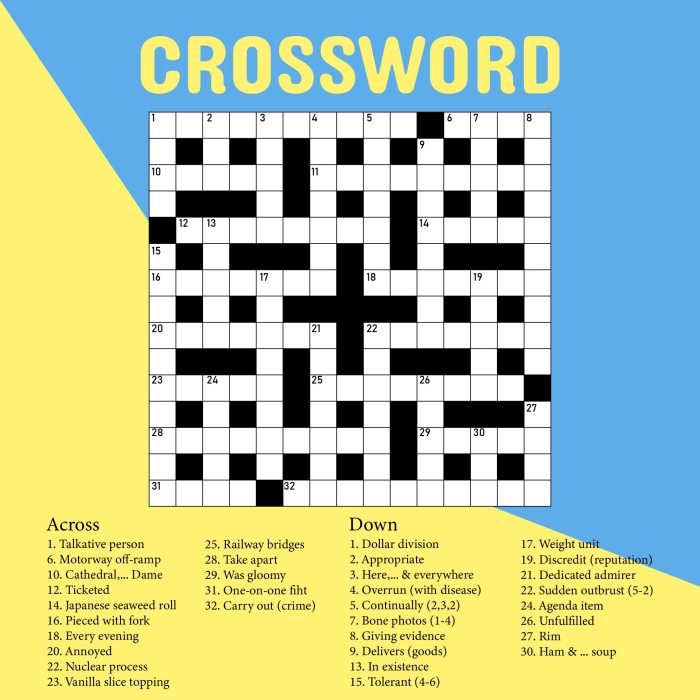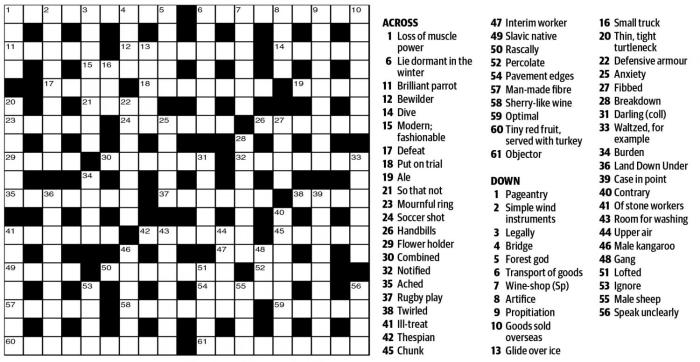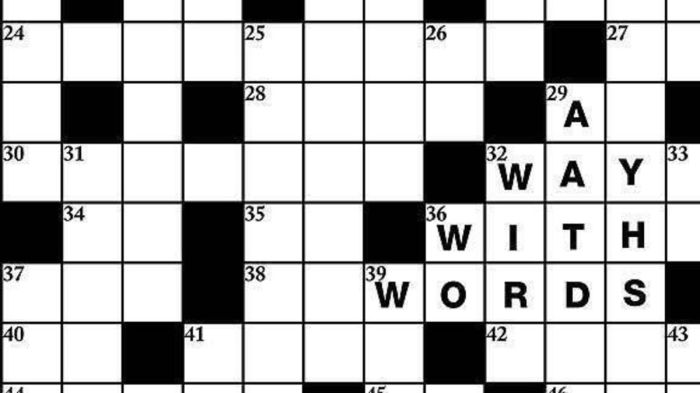One who is one crossword – Embark on a captivating journey as we delve into the enigmatic world of “One Who Is One,” a concept that has captivated minds and inspired countless interpretations throughout history. From its etymological roots to its profound philosophical and religious implications, this exploration promises to shed light on the multifaceted nature of this enigmatic term.
Throughout this discourse, we will traverse literary and artistic realms, uncovering how the concept of “One Who Is One” has been portrayed and interpreted in various contexts. We will examine its significance in modern applications, exploring its relevance to personal growth, social unity, and environmental consciousness.
Etymology of “One Who Is One”

The term “One Who Is One” has a rich and multifaceted etymology, drawing influences from ancient spiritual traditions and philosophical inquiries. Its origins can be traced back to the concept of the divine oneness, a fundamental belief in the unity of all existence.In
ancient Egypt, the concept of “One Who Is One” was embodied in the deity Amun-Ra, who was considered the supreme creator and sustainer of the universe. This idea of a single, all-encompassing being was also prevalent in other ancient civilizations, such as Mesopotamia and Greece.The
The one who is one crossword puzzle can be challenging to solve, especially when you have limited information. For example, if you are given qr pt and qpr str, it can be difficult to know what to do next. However, if you can find the answer to given qr pt and qpr str , it will be much easier to solve the crossword puzzle.
term “One Who Is One” gained further significance in the context of mysticism and spiritual practices. In the Upanishads, the ancient Indian sacred texts, the concept of Brahman, the ultimate reality, is described as “One without a second.” This notion of a singular, transcendent being became central to many spiritual traditions, including Hinduism, Buddhism, and Sufism.In
Western philosophy, the concept of “One Who Is One” has been explored by thinkers such as Plato and Plotinus. Plato’s theory of Forms posits the existence of a realm of perfect and unchanging entities, including the One, which represents the ultimate source of all reality.
Plotinus, a Neoplatonic philosopher, developed the idea of the One as the ultimate principle beyond being and thought, the source of all existence and the goal of all spiritual striving.The term “One Who Is One” continues to resonate in contemporary spiritual and philosophical discourse, representing the aspiration for unity, transcendence, and a deeper understanding of the nature of reality.
Symbolic Interpretations of “One Who Is One”

The concept of “One Who Is One” has been interpreted symbolically in various ways throughout history and across cultures. This enigmatic term often represents unity, wholeness, or individuality, embodying profound philosophical and spiritual meanings.
Unity and Oneness
In many cultures, “One Who Is One” symbolizes the interconnectedness and unity of all things. It suggests that despite our differences, we are all part of a larger whole, a cosmic web of existence. This interpretation emphasizes the importance of harmony, cooperation, and the breaking down of barriers that divide us.
Wholeness and Completion
The term “One Who Is One” can also represent wholeness and completeness. It implies that within each individual lies the potential for self-realization and the integration of all aspects of one’s being. This interpretation encourages personal growth, self-discovery, and the pursuit of a balanced and fulfilling life.
Individuality and Uniqueness
In some contexts, “One Who Is One” symbolizes the uniqueness and individuality of each person. It acknowledges that every individual possesses their own unique gifts, talents, and perspectives. This interpretation encourages self-expression, authenticity, and the celebration of diversity.
Literary and Artistic Depictions of “One Who Is One”: One Who Is One Crossword

The concept of “One Who Is One” has inspired numerous literary and artistic works, each offering a unique interpretation of this enigmatic figure. These works delve into the nature of unity, individuality, and the search for meaning in a complex and often fragmented world.
Novels and Short Stories
In literature, the idea of “One Who Is One” often manifests in characters who embody a sense of wholeness and self-awareness. For instance, in Hermann Hesse’s novel Siddhartha, the titular protagonist embarks on a spiritual journey to discover his true self, ultimately achieving a state of oneness with the universe.
Similarly, in Toni Morrison’s novel Beloved, the character Sethe represents a powerful symbol of resilience and unity amidst the horrors of slavery.
Poetry
Poetry has also explored the theme of “One Who Is One” through evocative imagery and symbolism. In Walt Whitman’s poem “Song of Myself,” the speaker celebrates the interconnectedness of all beings, declaring, “I am large, I contain multitudes.” Similarly, in Emily Dickinson’s poem “Because I could not stop for Death,” the speaker confronts the inevitability of death with a sense of acceptance and unity with the unknown.
Visual Arts
In the realm of visual arts, the concept of “One Who Is One” has been expressed through various mediums. In painting, artists like Wassily Kandinsky and Piet Mondrian sought to create abstract works that evoked a sense of harmony and balance, reflecting the unity of the universe.
Similarly, in sculpture, artists like Henry Moore and Barbara Hepworth explored the concept of form and unity through organic shapes and abstract compositions.
Philosophical and Religious Perspectives on “One Who Is One”

The concept of “One Who Is One” holds profound philosophical and religious implications. Across diverse belief systems, it has been interpreted as a symbol of oneness, divinity, and the ultimate goal of self-realization.
In monotheistic religions such as Christianity, Judaism, and Islam, “One Who Is One” is often associated with the concept of a single, all-powerful deity. This deity is seen as the creator and sustainer of the universe, and the source of all truth and goodness.
Hinduism and Buddhism, One who is one crossword
In Hinduism, the concept of “One Who Is One” is known as Brahman, the ultimate reality from which all things emerge. Brahman is seen as both immanent and transcendent, both within and beyond the universe. The goal of Hinduism is to achieve moksha, or liberation from the cycle of rebirth, through the realization of one’s true nature as Brahman.
In Buddhism, the concept of “One Who Is One” is often associated with the Buddha, who is seen as the enlightened one. The Buddha’s teachings emphasize the importance of self-realization and the cultivation of compassion and wisdom. The ultimate goal of Buddhism is to achieve nirvana, a state of liberation from suffering and the cycle of rebirth.
Taoism and Confucianism
In Taoism, the concept of “One Who Is One” is known as the Tao, the ultimate reality that underlies all things. The Tao is seen as both mysterious and elusive, and the goal of Taoism is to live in harmony with the Tao by following its natural flow.
In Confucianism, the concept of “One Who Is One” is often associated with the concept of ren, or humaneness. Ren is seen as the virtue that distinguishes humans from animals, and the goal of Confucianism is to cultivate ren through education and self-cultivation.
Conclusion
The concept of “One Who Is One” is a complex and multifaceted one that has been interpreted in a variety of ways across different philosophical and religious traditions. However, at its core, it represents a deep human yearning for unity, connection, and self-realization.
Contemporary Applications of “One Who Is One”
The concept of “One Who Is One” finds resonance in various modern contexts, fostering personal growth, social unity, and environmental consciousness.
Personal Growth
Embracing the “One Who Is One” perspective promotes self-awareness and personal integration. By recognizing the interconnectedness of all things, individuals cultivate a sense of wholeness and balance within themselves. This holistic approach empowers individuals to navigate life’s challenges with resilience and purpose.
Social Unity
The “One Who Is One” concept serves as a catalyst for bridging social divides. By recognizing the shared humanity and interconnectedness of all individuals, it fosters empathy, compassion, and a sense of collective responsibility. This perspective promotes inclusivity, tolerance, and the breaking down of barriers that separate people.
Environmental Consciousness
The “One Who Is One” philosophy aligns with the growing awareness of our interconnectedness with the natural world. It emphasizes the stewardship role we have as part of a larger ecosystem. By recognizing the interdependence of all living beings, individuals are inspired to adopt sustainable practices and advocate for the preservation of the environment.
FAQ Summary
What is the origin of the term “One Who Is One”?
The term “One Who Is One” has ancient roots, tracing back to the concept of monism in early philosophical and religious traditions.
How has the concept of “One Who Is One” been interpreted symbolically?
Throughout history, “One Who Is One” has been used to represent unity, wholeness, and the interconnectedness of all things.
Can you provide examples of literary works that explore the concept of “One Who Is One”?
Herman Hesse’s “Siddhartha” and Rumi’s poetry are notable examples that delve into the themes of unity and self-discovery.